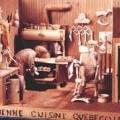 To enter the Musée du patrimoine Louis-Emile-Beauregard in Dudswell, Quebec, is to enter a land of Lilliputian delight. Take a trip to yesteryear and visit the miniature world of Louis-Émile Beauregard, where, as the brochure proclaims, "your amazement is guaranteed."
To enter the Musée du patrimoine Louis-Emile-Beauregard in Dudswell, Quebec, is to enter a land of Lilliputian delight. Take a trip to yesteryear and visit the miniature world of Louis-Émile Beauregard, where, as the brochure proclaims, "your amazement is guaranteed."
The genius of Louis-Émile Beauregard (1922-1989), like that of Jonathan Swift, plays upon our imagination. His oeuvre of 64 working miniature models and scenes, made of wood and built to scale, will enthrall children and adults alike. Here you can discover tiny, fully functioning farm machinery; a wee schoolhouse where the teacher interacts with her pupils; and a kitchen scene where a wife bakes cookies in the wood stove while her pipe-smoking husband relaxes in his rocking chair.
But, the piece-de-resistance is the incredibly detailed general store displaying shelves stacked with cereals, pots, clothing, and countless other necessities. A double-barreled shotgun hanging on the wall of the store breaks open to load cartridges. The scale, beside the store's proprietor, works also, as does the grain mill, washboards, and meat grinders behind him.
"I CAN FEEL THEIR PRESENCE"
Feeling like the "man-mountain" Gulliver, I found myself to be a wonderer in a fantasy world, a world where the models could come to life at any moment. I swear that I detected movement when I would look away and back quickly, and thankfully, I am not the only one to feel this way. "Your feeling is good; it's their life that we are looking at," Museum Director Nancy Duchesne said. "The person that installed the display felt the people were alive and in a state of constant movement, and several visitors have told me that they are certain a model has moved."
"All the models are in a position of motion; not one is static, and so we naturally fall into the movement of action with them," Duchesne continued. "When I work late at night, I can feel their presence, and sometimes that of Louis-Émile, and I know that I'm not alone. They are with me."
 Duchesne went on to say, that the reason Beauregard's "people" look so real is probably because Beauregard would ask his daughter to stand in front of a mirror while he carved his characters. He would study the way her clothes hung, for example, and he would incorporate the wrinkles into his creations.
Duchesne went on to say, that the reason Beauregard's "people" look so real is probably because Beauregard would ask his daughter to stand in front of a mirror while he carved his characters. He would study the way her clothes hung, for example, and he would incorporate the wrinkles into his creations.
POSTMASTER AND SCULPTOR
Beauregard, who regarded himself as a sculptor and a handyman, was a postmaster by trade and never worked on a farm, but he had a high regard for farmers and enjoyed sculpting models of farm machinery. "Farm machinery fascinates me," he would say. "And I want to leave something to remember them by." Beauregard and his daughter would locate an old rusting piece of machinery, then his daughter would photograph the object while Beauregard took its measurements. He was always careful to carve his work to the scale of 1.5 inches to the foot.
Beauregard learned his woodworking skills from his father: "My father lent me the tools and I supplied the creativity." Beauregard never took courses and made the models in his spare time over a period of eleven years, beginning at the age of 55. Some of his models took 40 to 50 hours to create, and his masterpiece, the general store, required more than 500 hours. Louis-Émile Beauregard vowed that his artwork would never be sold as long as he lived.